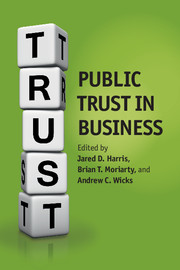Book contents
- Frontmatter
- Contents
- List of figures
- List of tables
- Notes on contributors
- Preface: discovering new territory in public trust in business
- Acknowledgments
- 1 Public trust in business: what’s the problem and why does it matter?
- Part I Trusting the institution of business
- 2 The economic crisis of 2008, trust in government, and generalized trust
- 3 Too big to trust? Managing stakeholder trust in business in the post-bail-out economy
- 4 At the crossroads of trust and distrust: skepticism and ambivalence toward business
- 5 Public trust in business and its determinants
- 6 The role of public, relational, and organizational trust in economic affairs
- Part II Public trust and business organizations
- Index
- References
4 - At the crossroads of trust and distrust: skepticism and ambivalence toward business
Published online by Cambridge University Press: 05 July 2014
- Frontmatter
- Contents
- List of figures
- List of tables
- Notes on contributors
- Preface: discovering new territory in public trust in business
- Acknowledgments
- 1 Public trust in business: what’s the problem and why does it matter?
- Part I Trusting the institution of business
- 2 The economic crisis of 2008, trust in government, and generalized trust
- 3 Too big to trust? Managing stakeholder trust in business in the post-bail-out economy
- 4 At the crossroads of trust and distrust: skepticism and ambivalence toward business
- 5 Public trust in business and its determinants
- 6 The role of public, relational, and organizational trust in economic affairs
- Part II Public trust and business organizations
- Index
- References
Summary
EXECUTIVE SUMMARY
the situation
Current analyses of public trust in business do not capture the new relationships and realities facing business in the twenty-first century.
key questions
What do high levels of distrust in business really mean? Is there a “new normal” with respect to trust and distrust in business? Should business leaders and policy makers be concerned about levels of trust in business? Are business accountability strategies and analytic tools effective for building public trust in business?
new knwowledge
Trust and distrust are not ends of the same continuum; rather, trust and distrust are two distinct phenomena, and both can exist simultaneously with respect to the public’s attitudes toward business. The simultaneous coexistence of trust and distrust creates the condition of ambivalence toward business. Trust tends to be a fairly stable phenomenon, but distrust also appears to be a resilient phenomenon, defining a new business landscape in which it does not fade away but is always present, if not always salient.
- Type
- Chapter
- Information
- Public Trust in Business , pp. 86 - 115Publisher: Cambridge University PressPrint publication year: 2014
References
- 3
- Cited by



